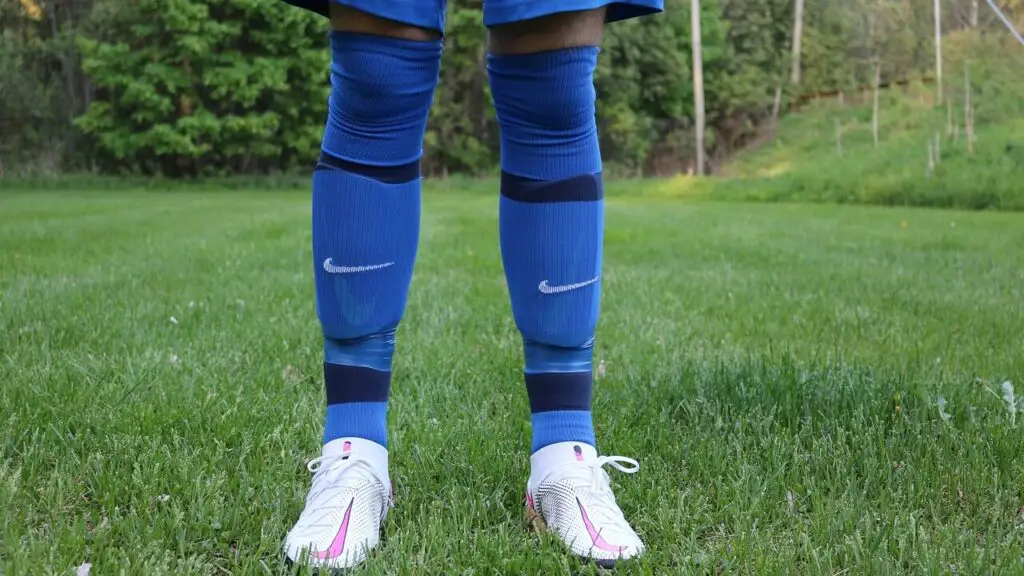What are soccer shin guards made of?
First things first, soccer is a beloved sport played by millions of people worldwide. Whether you’re a beginner or a seasoned player, one thing remains constant: the need for soccer shin guards.
These essential pieces of equipment protect your shins from the impact of tackles, kicks, and other impacts during play.
In this post, we’ll explore the materials used to make soccer shin guards and their importance in keeping you safe on the field.
The History of Soccer Shin Guards
Shin guards have been around since the early days of soccer. The first shin guards were made of leather and were worn by cricket players in England in the late 1800s. As soccer grew in popularity, players began to wear shin guards made of a variety of materials, including wood, metal, and even fiberglass.
Today, soccer shin guards are made from a variety of materials, each with its unique benefits and drawbacks. Let’s take a closer look at some of the most common materials used to make soccer shin guards.
What are Soccer Shin Guards made of?
- Plastic
Plastic is a popular material for soccer shin guards because it’s lightweight, durable, and affordable. Most plastic shin guards are made of a hard outer shell with foam padding on the inside to absorb impact. These shin guards are easy to clean and maintain, making them a popular choice for players at all levels.
- Fiberglass
Fiberglass is a more expensive material than plastic, but it offers superior protection and durability. Fiberglass shin guards are made of a hard outer shell with multiple layers of fiberglass on the inside to absorb impact. These shin guards are ideal for players who need extra protection, such as defenders or goalkeepers.
- Kevlar
Kevlar is a synthetic material that’s known for its strength and durability. Kevlar shin guards are made of a hard outer shell with layers of Kevlar on the inside to absorb impact. These shin guards are often used by professional players and are the most expensive type of shin guard on the market.
- Foam
Foam shin guards are the most basic type of shin guard available. They’re made of a single layer of foam that’s designed to absorb impact. Foam shin guards are inexpensive and lightweight, but they don’t offer as much protection as other types of shin guards.
- Carbon Fiber
Carbon fiber is a high-performance material that’s known for its strength and lightweight. Carbon fiber shin guards are made of a hard outer shell with layers of carbon fiber on the inside to absorb impact. These shin guards are often used by professional players and are the most expensive type of shin guard on the market.
==>> You can also read my article on whether soccer shin guards can be washed here.
Which Material is Right for You?
Choosing the right shin guard material depends on a variety of factors, including your position on the field, your playing style, and your budget.
If you’re a defender or goalkeeper who needs extra protection, a fiberglass or Kevlar shin guard may be the best choice. If you’re a forward who values speed and agility, a lightweight plastic or foam shin guard may be a better option.
It’s also important to consider your budget when choosing a shin guard material.
While carbon fiber and Kevlar shin guards offer superior protection, they’re also the most expensive option. If you’re a beginner or a casual player, a plastic or foam shin guard may be a more affordable choice.
The Importance of Proper Fit

No matter what material you choose, it’s important to make sure your shin guards fit properly. A poorly fitting shin guard can move around during play, leaving your shins unprotected and increasing your risk of injury.
If you’re in the market for a new set of shin guards, it’s crucial to take the time to try them on first. Find a pair that fits securely around your shin without causing any discomfort or restrictions.
Additionally, ensure that the shin guards cover the entirety of your shin, starting just above your ankle and extending down to just below your knee. By selecting the right fit, you can enjoy added confidence and protection during your sporting activities.
It’s also important to consider the style of shin guard you prefer. Some shin guards come with a sleeve that holds them in place, while others have straps that wrap around your calf. The style you choose is a matter of personal preference, but make sure you choose a style that feels comfortable and secure during play.
Maintaining Your Shin Guards
Once you’ve chosen the right shin guards for your needs, it’s important to take proper care of them. Proper maintenance can help extend the life of your shin guards and keep them performing at their best.
After each use, wipe down your shin guards with a damp cloth to remove dirt and sweat.
If your shin guards are washable, follow the manufacturer’s instructions for cleaning. Be sure to let your shin guards air dry before storing them.
==>> Can soccer shin guards be washed?
It’s also a good idea to inspect your shin guards regularly for signs of wear and tear. Look for cracks, dents, or other damage that could compromise their ability to protect your shins. If you notice any damage, replace your shin guards immediately to avoid the risk of injury.
Wrap Up
In Conclusion, Soccer shin guards are an essential piece of equipment for players at all levels. They protect your shins from the impact of tackles, kicks, and other impacts during play.
The material you choose depends on your position, playing style, and budget.
Whether you choose plastic, fiberglass, Kevlar, foam, or carbon fiber, make sure your shin guards fit properly and are well-maintained.
With the right shin guards, you can stay safe and focused on the game, knowing that you’re protected from injury.

